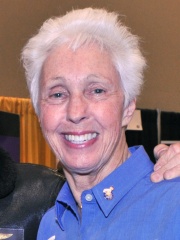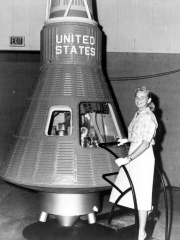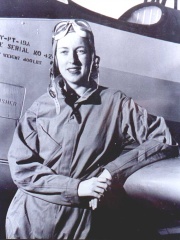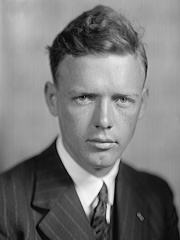
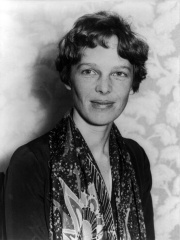
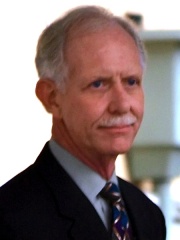
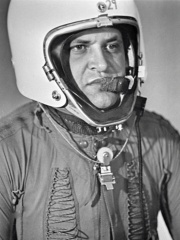
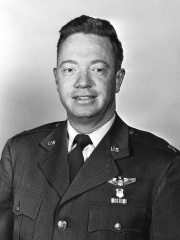
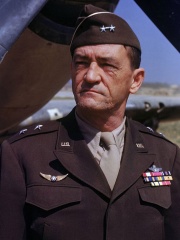
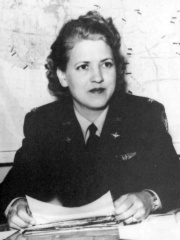
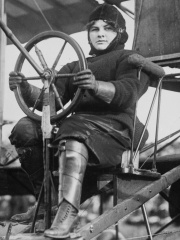
The Most Famous
PILOTS from United States
This page contains a list of the greatest American Pilots. The pantheon dataset contains 71 Pilots, 13 of which were born in United States. This makes United States the birth place of the 2nd most number of Pilots.
Top 10
The following people are considered by Pantheon to be the top 10 most legendary American Pilots of all time. This list of famous American Pilots is sorted by HPI (Historical Popularity Index), a metric that aggregates information on a biography's online popularity. Visit the rankings page to view the entire list of American Pilots.

1. Charles Lindbergh (1902 - 1974)
With an HPI of 81.92, Charles Lindbergh is the most famous American Pilot. His biography has been translated into 74 different languages on wikipedia.
Charles Augustus Lindbergh (February 4, 1902 – August 26, 1974) was an American aviator, military officer, and author. On May 20–21, 1927, he made the first nonstop flight from New York to Paris, a distance of 3,600 miles (5,800 km), flying alone for over 33 hours. His aircraft, the Spirit of St. Louis, was built to compete for the $25,000 Orteig Prize for the first flight between the two cities. Although not the first transatlantic flight, it was the first solo crossing of the Atlantic and the longest at the time by nearly 2,000 miles (3,200 km), setting a new flight distance world record. The achievement garnered Lindbergh worldwide fame and stands as one of the most consequential flights in history, signalling a new era of air transportation between parts of the globe. Lindbergh was raised mostly in Little Falls, Minnesota, and Washington, D.C., the son of U.S. congressman Charles August Lindbergh. He became a U.S. Army Air Service cadet in 1924. The next year, he was hired as a U.S. Air Mail pilot in the Greater St. Louis area, where he began to prepare for crossing the Atlantic. For his 1927 flight, President Calvin Coolidge presented him both the Distinguished Flying Cross and Medal of Honor, the highest U.S. military award. He was promoted to colonel in the U.S. Army Air Corps Reserve and also earned the highest French order of merit, the Legion of Honor. His achievement spurred significant global interest in flight training, commercial aviation and air mail, which revolutionized the aviation industry worldwide (a phenomenon dubbed the "Lindbergh Boom"), and he spent much time promoting these industries. Time magazine named Lindbergh its first Man of the Year for 1927, President Herbert Hoover appointed him to the National Advisory Committee for Aeronautics in 1929, and he received the Congressional Gold Medal in 1930. In 1931, he and French surgeon Alexis Carrel began work on inventing the first perfusion pump, a device credited with making future heart surgeries and organ transplantation possible. On March 1, 1932, Lindbergh's first-born infant child, Charles Jr., was kidnapped and murdered in what the American media called the "crime of the century". The case prompted the U.S. to establish kidnapping as a federal crime if a kidnapper crosses state lines with a victim. By late 1935, public hysteria from the case drove the Lindbergh family abroad to Europe, from where they returned in 1939. In the months before the United States entered World War II, Lindbergh's non-interventionist stance and statements about Jews and race led many to believe he was a Nazi sympathizer. Lindbergh never publicly stated support for the Nazis and condemned them several times in both his public speeches and personal diary, but associated with them on numerous occasions in the 1930s. He also supported the isolationist America First Committee and resigned from the U.S. Army Air Corps in April 1941 after President Franklin Roosevelt publicly rebuked him for his views. In September 1941, Lindbergh gave a significant address, titled "Speech on Neutrality", outlining his position and arguments against greater American involvement in the war. Following the Japanese attack on Pearl Harbor and German declaration of war against the U.S., Lindbergh avidly supported the American war effort but was rejected for active duty, as Roosevelt refused to restore his colonel's commission. Instead he flew 50 combat missions in the Pacific Theater as a civilian consultant and was unofficially credited with shooting down an enemy aircraft. In 1954, President Dwight Eisenhower restored his commission and promoted him to brigadier general in the U.S. Air Force Reserve. In his later years, he became a Pulitzer Prize-winning author, international explorer and environmentalist, helping to establish national parks in the U.S. and protect certain endangered species and tribal people in both the Philippines and east Africa. After retiring in Maui, Lindbergh died of lymphoma in 1974 at the age of 72.

2. Amelia Earhart (1897 - 1937)
With an HPI of 77.69, Amelia Earhart is the 2nd most famous American Pilot. Her biography has been translated into 106 different languages.
Amelia Mary Earhart ( AIR-hart; born July 24, 1897; disappeared July 2, 1937; declared dead January 5, 1939) was an American aviation pioneer. On July 2, 1937, she disappeared over the Pacific Ocean while attempting to become the first female pilot to circumnavigate the world. During her life, Earhart embraced celebrity culture and women's rights, and since her disappearance has become a global cultural figure. She was the first female pilot to fly solo non-stop across the Atlantic Ocean and set many other records. She was one of the first aviators to promote commercial air travel, wrote best-selling books about her flying experiences, and was instrumental in the formation of the Ninety-Nines, an organization for female pilots. Earhart was born and raised in Atchison, Kansas, and developed a passion for adventure at a young age, steadily gaining flying experience from her twenties. In 1928, she became a celebrity after becoming the first female passenger to cross the Atlantic by airplane. In 1932, she became the first woman to make a nonstop solo transatlantic flight, and was awarded the Distinguished Flying Cross for her achievement. In 1935, she became a visiting faculty member of Purdue University as an advisor in aeronautical engineering and a career counselor to female students. She was a member of the National Woman's Party and an early supporter of the Equal Rights Amendment. She was one of the most inspirational American figures from the late 1920s and throughout the 1930s. Her legacy is often compared to that of the early career of pioneer aviator Charles Lindbergh, as well as First Lady Eleanor Roosevelt for their close friendship and lasting influence on women's causes. In 1937, during an attempt to become the first woman to complete a circumnavigational flight of the globe, flying a Lockheed Model 10-E Electra airplane, Earhart and her navigator Fred Noonan disappeared near Howland Island in the central Pacific Ocean. The two were last seen in Lae, New Guinea, their last land stop before Howland Island, a very small location where they were intending to refuel. It is generally believed that they ran out of fuel before they found Howland Island and crashed into the ocean near their destination. Nearly one year and six months after she and Noonan disappeared, Earhart was officially declared dead. She would have been 41 years of age. The mysterious nature of Earhart's disappearance has caused much public interest in her life. Her airplane has never been found, which has led to speculation and conspiracy theories about the outcome of the flight. Decades after her presumed death, Earhart was inducted into the National Aviation Hall of Fame in 1968 and the National Women's Hall of Fame in 1973. Several commemorative memorials in the United States have been named in her honor; these include a commemorative US airmail stamp, an airport, a museum, a bridge, a cargo ship, an earth-fill dam, a playhouse, a library, and multiple roads and schools. She also has a minor planet, planetary corona, and lunar crater named after her. Numerous films, documentaries, and books have recounted Earhart's life, and she is ranked ninth on Flying's list of the 51 Heroes of Aviation.

3. Chesley Sullenberger (b. 1951)
With an HPI of 74.99, Chesley Sullenberger is the 3rd most famous American Pilot. His biography has been translated into 32 different languages.
Chesley Burnett "Sully" Sullenberger III (born January 23, 1951) is an American retired aircraft pilot, diplomat and aviation safety expert. He is best known for his actions as captain of US Airways Flight 1549 on January 15, 2009, when he ditched the plane, landing on the Hudson River after both engines were disabled by a bird strike. All 155 people aboard survived. After the Hudson landing, Sullenberger became an outspoken advocate for aviation safety and helped develop new protocols for flight safety. He served as the co-chairman, along with his co-pilot on Flight 1549, Jeffrey Skiles, of the Experimental Aircraft Association (EAA)'s Young Eagles youth introduction-to-aviation program from 2009 to 2013. Sullenberger retired from US Airways in 2010, after 30 years as a commercial pilot. In 2011, he was hired by CBS News as an aviation and safety expert. Sullenberger is the co-author, with Jeffrey Zaslow, of the New York Times bestseller Highest Duty: My Search for What Really Matters, a memoir of his life and of the events surrounding Flight 1549. His second book, Making a Difference: Stories of Vision and Courage from America's Leaders, was published in 2012. He was ranked second in Time's Top 100 Most Influential Heroes and Icons of 2009, after Michelle Obama. In 2021, President Joe Biden announced he would nominate Sullenberger as U.S. representative to the International Civil Aviation Organization (ICAO) with the rank of ambassador. He was confirmed by unanimous consent in the Senate and served in that role from February 3 to July 1, 2022.

4. Francis Gary Powers (1929 - 1977)
With an HPI of 67.72, Francis Gary Powers is the 4th most famous American Pilot. His biography has been translated into 41 different languages.
Francis Gary Powers (August 17, 1929 – August 1, 1977) was an American pilot who served as a United States Air Force officer and a CIA employee. Powers is best known for his involvement in the 1960 U-2 incident, when he was shot down while flying a secret CIA spying mission over the Soviet Union. Powers survived, but was captured and sentenced to 10 years in a Soviet prison for espionage. He served 21 months of his sentence before being released in a prisoner swap in 1962. After returning to the US, he worked at Lockheed as a test pilot for the U-2, and later as a helicopter pilot for Los Angeles news station KNBC. He died in 1977, when the KNBC helicopter he was flying crashed.
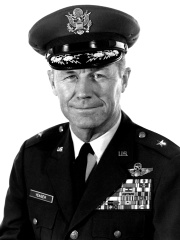
5. Chuck Yeager (1923 - 2020)
With an HPI of 65.85, Chuck Yeager is the 5th most famous American Pilot. His biography has been translated into 52 different languages.
Brigadier General Charles Elwood Yeager ( YAY-gər, February 13, 1923 – December 7, 2020) was a United States Air Force officer, flying ace, and record-setting test pilot who in October 1947 became the first pilot in history confirmed to have exceeded the speed of sound in level flight. He wrote two books about his life, "Yeager" and "Press On: Further Adventures in the Good Life." Yeager was raised in Hamlin, West Virginia. His career began in World War II as a private in the United States Army, assigned to the Army Air Forces in 1941. After serving as an aircraft mechanic, in September 1942, he entered enlisted pilot training and upon graduation was promoted to the rank of flight officer (the World War II Army Air Force version of the Army's warrant officer), later achieving most of his aerial victories as a P-51 Mustang fighter pilot on the Western Front, where he was credited with shooting down 11.5 enemy aircraft. The half credit is from a second pilot assisting him in a single shootdown. On October 12, 1944, he attained "ace in a day" status, shooting down five enemy aircraft in one mission. After the war, Yeager became a test pilot and flew many types of aircraft, including experimental rocket-powered aircraft for the National Advisory Committee for Aeronautics (NACA). Through the NACA program, he became the first human to officially break the sound barrier on October 14, 1947, when he flew the experimental Bell X-1 at Mach 1.05 at an altitude of 45,000 ft (13,700 m), for which he won both the Collier and Mackay trophies in 1948. He broke several other speed and altitude records in the following years. In 1962, he became the first commandant of the USAF Aerospace Research Pilot School, which trained and produced astronauts for NASA and the Air Force. Yeager later commanded fighter squadrons and wings in Germany, as well as in Southeast Asia during the Vietnam War. In recognition of his achievements and the outstanding performance ratings of those units, he was promoted to brigadier general in 1969 and inducted into the National Aviation Hall of Fame in 1973, retiring on March 1, 1975, for its colloquial similarity to "Mach 1". His three-war active-duty flying career spanned more than 30 years and took him to many parts of the world, including the Korean War zone and the Soviet Union during the height of the Cold War. Yeager is referred to by many as one of the greatest pilots of all time, and was ranked fifth on Flying's list of the 51 Heroes of Aviation in 2013. He flew more than 360 different types of aircraft over a 70-year period, and continued to fly for two decades after retirement as a consultant pilot for the United States Air Force. In 2020 at the age of 97, Yeager died in a Los Angeles-area hospital.

6. Joseph Kittinger (1928 - 2022)
With an HPI of 62.79, Joseph Kittinger is the 6th most famous American Pilot. His biography has been translated into 33 different languages.
Joseph William Kittinger II (July 27, 1928 – December 9, 2022) was an American military pilot who was an officer in the United States Air Force. He served from 1950 to 1978 and earned Command Pilot status before retiring with the rank of colonel. He held the world record for the highest skydive—102,800 feet (31.3 km)—from 1960 until 2012. Kittinger participated in the Project Manhigh and Project Excelsior high-altitude balloon flight projects from 1956 to 1960 and was the first man to fully witness the curvature of the Earth. A fighter pilot during the Vietnam War, Kittinger shot down a North Vietnamese MiG-21 jet fighter. He was later shot down as well, subsequently spending 11 months as a prisoner of war in a North Vietnamese prison before he was repatriated in 1973. In 1984, Kittinger became the first person to make a solo crossing of the Atlantic Ocean in a gas balloon. In 2012, Kittinger participated in the Red Bull Stratos project as capsule communicator at age 84, directing Felix Baumgartner on his 24-mile (39 km) freefall from Earth's stratosphere, which broke Kittinger's own 53-year-old record. Felix Baumgartner's record would be broken two years later by Alan Eustace.

7. Claire Lee Chennault (1890 - 1958)
With an HPI of 61.70, Claire Lee Chennault is the 7th most famous American Pilot. Her biography has been translated into 25 different languages.
Claire Lee Chennault (September 6, 1893 – July 27, 1958) was an American military aviator best known for his leadership of the "Flying Tigers" and the Chinese Nationalist Air Force in World War II. Chennault was a fierce advocate of "pursuit" or fighter-interceptor aircraft during the 1930s when the United States Army Air Corps was focused primarily on high-altitude bombardment. Chennault retired from the United States Army in 1937, and went to work as an aviation adviser and trainer in China. Starting in early 1941, Chennault commanded the 1st American Volunteer Group (nicknamed Flying Tigers). He headed both the volunteer group and the uniformed U.S. Army Air Forces units that replaced it in 1942. He feuded constantly with General Joseph Stilwell, the U.S. Army commander in China, and helped China's Generalissimo Chiang Kai-shek to convince President Roosevelt to remove Stilwell in 1944. The China-Burma-India theater was strategically essential in order to fix many vital elements of the Imperial Japanese Army on the Chinese mainland to limit their use against Allied forces advancing towards Japan in the two Pacific campaigns.

8. Jacqueline Cochran (1906 - 1980)
With an HPI of 59.50, Jacqueline Cochran is the 8th most famous American Pilot. Her biography has been translated into 29 different languages.
Jacqueline Cochran (May 11, 1906 – August 9, 1980) was an American pilot and business executive. She pioneered women's aviation as one of the most prominent racing pilots of her generation. She set numerous records and was the first woman to break the sound barrier on 18 May 1953. Cochran (along with Nancy Love) was the wartime head of the Women Airforce Service Pilots (WASP) (1943–1944), which employed about 1000 civilian American women in a non-combat role to ferry planes from factories to port cities. Later on, Cochran was initially a sponsor of the Mercury 13 women astronaut program, before testifying against it in a congressional Subcommittee.

9. Blanche Stuart Scott (1884 - 1970)
With an HPI of 58.85, Blanche Stuart Scott is the 9th most famous American Pilot. Her biography has been translated into 15 different languages.
Blanche Stuart Scott (April 8, 1885 – January 12, 1970), also known as Betty Scott, was possibly the first American woman aviator. For her automobile journey across the United States she won the attention and admiration of pioneer aviator Glenn Curtiss who gave her flying lessons at the Curtiss flying school, in Hammondsport, New York, America's first flying school.
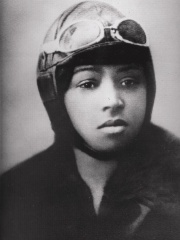
10. Bessie Coleman (1892 - 1926)
With an HPI of 57.43, Bessie Coleman is the 10th most famous American Pilot. Her biography has been translated into 41 different languages.
Elizabeth Coleman (January 26, 1892 – April 30, 1926) was an early American civil aviator. She was the first African-American woman and first Native American to hold a pilot license, and is the earliest known Black person to earn an international pilot's license. She earned her license from the Fédération Aéronautique Internationale on June 15, 1921. Born to a family of sharecroppers in Texas, Coleman worked in the cotton fields at a young age while also studying in a small segregated school. She attended one term of college at Langston University. Coleman developed an early interest in flying, but African Americans, Native Americans, and women had no flight training opportunities in the United States, so she saved and obtained sponsorships in Chicago to go to France for flight school. She then became a high-profile pilot in notoriously dangerous air shows in the United States. She was popularly known as "Queen Bess" and "Brave Bessie", and hoped to start a school for African-American fliers. Coleman died in a plane crash in 1926. Her pioneering role was an inspiration to early pilots and to the African-American and Native American communities.
People
Pantheon has 13 people classified as American pilots born between 1884 and 1951. Of these 13, 2 (15.38%) of them are still alive today. The most famous living American pilots include Chesley Sullenberger, and Wally Funk. The most famous deceased American pilots include Charles Lindbergh, Amelia Earhart, and Francis Gary Powers.
Living American Pilots
Go to all RankingsDeceased American Pilots
Go to all RankingsCharles Lindbergh
1902 - 1974
HPI: 81.92
Amelia Earhart
1897 - 1937
HPI: 77.69
Francis Gary Powers
1929 - 1977
HPI: 67.72
Chuck Yeager
1923 - 2020
HPI: 65.85
Joseph Kittinger
1928 - 2022
HPI: 62.79
Claire Lee Chennault
1890 - 1958
HPI: 61.70
Jacqueline Cochran
1906 - 1980
HPI: 59.50
Blanche Stuart Scott
1884 - 1970
HPI: 58.85
Bessie Coleman
1892 - 1926
HPI: 57.43
Jerrie Cobb
1931 - 2019
HPI: 54.00
Cornelia Fort
1919 - 1943
HPI: 49.87
Overlapping Lives
Which Pilots were alive at the same time? This visualization shows the lifespans of the 10 most globally memorable Pilots since 1700.

